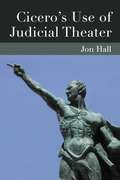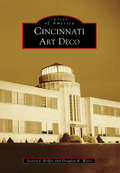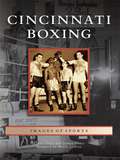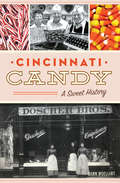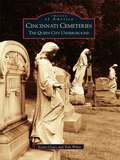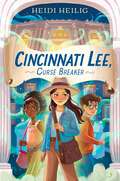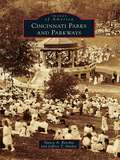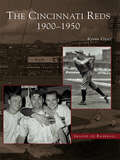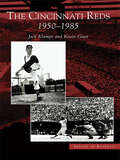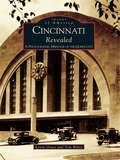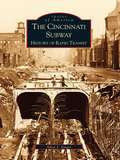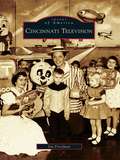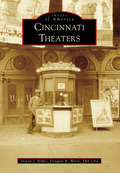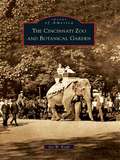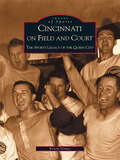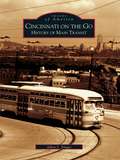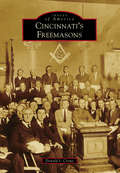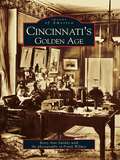- Table View
- List View
Cicero Revisited
by Douglas DeuchlerStrategically located seven miles west of Chicago's Loop, multifaceted Cicero is one of the oldest and largest municipalities in Illinois. In the late 19th century, this unique industrial suburb developed as an ethnic patchwork of self-sufficient immigrant neighborhoods. Since the Roaring Twenties, when mobster kingpin Al Capone set up shop there, the town has often been characterized by corruption and controversy. Yet the Cicero story continues to be full of promise and adventure, vision and accomplishment. As its population has shifted from heavily eastern European to predominantly Hispanic, Cicero remains a vibrant community where residents maintain strong civic pride, work ethic, and family values.
Cicero's Use Of Judicial Theater
by Jonathan HallIn Cicero's Use of Judicial Theater, Jon Hall examines Cicero's use of showmanship in the Roman courts, looking in particular at the nonverbal devices that he employs during his speeches as he attempts to manipulate opinion. Cicero's speeches in the law-courts often incorporate theatrical devices including the use of family relatives as props during emotional appeals, exploitation of tears and supplication, and the wearing of specially dirtied attire by defendants during a trial, all of which contrast strikingly with the practices of the modem advocate. Hall investigates how Cicero successfully deployed these techniques and why they played such a prominent part in the Roman courts. These "judicial theatrics" are rarely discussed by the ancient rhetorical handbooks, and Cicero's Use of Judicial Theater argues that their successful use by Roman orators derives largely from the inherent theatricality of aristocratic life in ancient Rome--most of the devices deployed in the courts appear elsewhere in the social and political activities of the elite. While Cicero's Use of Judicial Theater will be of interest primarily to professional scholars and students studying the speeches of Cicero, its wider analyses, both of Roman cultural customs and the idiosyncratic practices of the courts, will prove relevant also to social historians, as well as historians of legal procedure.
Cien años de soledad (edición ilustrada)
by Gabriel García MárquezEn ocasión del 50 aniversario de la publicación de Cien años de soledad, llega una edición con ilustraciones inéditas de la artista chilena Luisa Rivera y con una tipografía creada por el hijo del autor, Gonzalo García Barcha. Una edición conmemorativa de una novela clave en la historia de la literatura, una obra que todos deberíamos tener en nuestras estanterías. «Muchos años después, frente al pelotón de fusilamiento, el coronel Aureliano Buendía había de recordar aquella tarde remota en que su padre lo llevó a conocer el hielo.» Con esta cita comienza una de las novelas más importantes del siglo XX y una de las aventuras literarias más fascinantes de todos los tiempos. Millones de ejemplares de Cien años de soledad leídos en todas las lenguas y el premio Nobel de Literatura coronando una obra que se había abierto paso «boca a boca» -como gustaba decir el escritor- sonla más palpable demostración de que la aventura fabulosa de la familia Buendía-Iguarán, con sus milagros, fantasías, obsesiones, tragedias, incestos, adulterios, rebeldías, descubrimientos y condenas, representaba al mismo tiempo el mito y la historia, la tragedia y el amor del mundo entero. El mejor homenaje a Gabo es leerlo. Pablo Neruda dijo...«El Quijote de nuestro tiempo.»
Cien años de soledad (edición ilustrada)
by Gabriel García Márquez Luisa RiveraEn ocasión del 50 aniversario de la publicación de Cien años de soledad, llega una edición con ilustraciones inéditas de la artista chilena Luisa Rivera y con una tipografía creada por el hijo del autor, Gonzalo García Barcha. Una edición conmemorativa de una novela clave en la historia de la literatura, una obra que todos deberíamos tener en nuestras estanterías. «Muchos años después, frente al pelotón de fusilamiento, el coronel Aureliano Buendía había de recordar aquella tarde remota en que su padre lo llevó a conocer el hielo.» Con esta cita comienza una de las novelas más importantes del siglo XX y una de las aventuras literarias más fascinantes de todos los tiempos. Millones de ejemplares de Cien años de soledad leídos en todas las lenguas y el premio Nobel de Literatura coronando una obra que se había abierto paso «boca a boca» -como gustaba decir el escritor- son la más palpable demostración de que la aventura fabulosa de la familia Buendía-Iguarán, con sus milagros, fantasías, obsesiones, tragedias, incestos, adulterios, rebeldías, descubrimientos y condenas, representaba al mismo tiempo el mito y la historia, la tragedia y el amor del mundo entero. El mejor homenaje a Gabo es leerlo. Pablo Neruda dijo...«El Quijote de nuestro tiempo.»
Cien películas que me abrieron la cabeza
by Nicolás Amelio OrtizCien películas que me abrieron la cabeza es el viaje personal al que nos invita Nicolás para compartir su intenso amor por el cine. Una experiencia vital que empezó en la adolescencia, cuando vio Vértigo de Hitchcock por primera vez, y que lo acompaña desde entonces. Lejos de todo canon, este libro no pretende ser la selección de las películas que tenés que ver antes de morir; ni la lista de las que te recomiendan una y otra vez los profesores de cine. Son simplemente cien que a Nico le abrieron un mundo, y más de una vez le partieron la cabeza. En estas páginas concebidas desde la pasión y el desprejuicio total, conviven una de Ingmar Bergman y otra con Jim Carrey; la elegante obra de Luchino Visconti con la de su más sangriento compatriota Dario Argento; obras maestras del cine americano de los 70 con títulos de jóvenes autores que están destinados a romperla en los próximos años. Y alguna menospreciada y monstruosa belleza clase B que un crítico acaso demasiado "serio" no se atrevería a incluir en ninguna lista. No necesitás saber nada de cine para zambullirte en este libro: solo dejarte llevar e hipnotizar; descubrir y discutir. Y estar listo para emprender, como le pasó a Nicolás, un viaje alucinante para toda la vida.
Cigar Aficionado's Pocket Guide
by Marvin R. ShankenHandy references no true aficionado should be without! This compact primer, revised and now in hardcover, includes information on tobacco production, cigar etiquette, humidor maintenance, and which drinks best complement a fine smoke. Features an up-to-date list of major premium cigar brands, comparative strength ratings, and a glossary of cigar terms.
Cincinnati Art Deco
by Douglas R. Weise Steven J. RolfesArt Deco, daring and almost defiant in its optimism, reflected the spirit of a restless time. Bursting forth in the midst of the Roaring Twenties, an age when there seemed to be no limits, this new art form was both elegant and modern. Cincinnati is fortunate to have three stunning examples of this unique style: the sophisticated Hilton Netherland Plaza hotel, the overwhelming Cincinnati Times-Star Building, and the Union Terminal. Beyond these giants, the Greater Cincinnati region is studded with many other breathtaking examples of Art Deco, from a water tower decorated with Christmas lights to stunning neighborhood theaters and apartment buildings to mythological creatures guarding a Masonic temple in northern Kentucky. There is no doubt that Art Deco is alive and well in Cincinnati, so grab a hip flask of bathtub gin, put on some Glenn Miller, and explore the elegance and history of Cincinnati Art Deco.
Cincinnati Boxing (Images of Sports)
by Kevin Grace Joshua Grace Buddy LarosaOn August 29, 1885, Cincinnati was the scene for the first modern heavyweight championship boxing match using gloves. The Boston Strong Boy, John L. Sullivan, met Dominick McCaffrey at the city's Chester Park that day and came away with the referee's decision. By this time, Cincinnati had been a noted boxing site since the Civil War years, and over the next several decades, it developed a remarkable number of fine boxers in both the professional and amateur ranks. Out of the many gymnasiums in Over-the-Rhine and the West End came world champions such as Freddie Miller, Ezzard Charles, Bud Smith, and Aaron Pryor. This book is the story of a fascinating aspect of Cincinnati's great sports heritage--the boxing game--with all its leather-punching drama. From the frontierlike matches of the 19th-century river town to the urban ethnic and social influences of the 20th and 21st centuries, Cincinnati Boxing brings a rich part of local history to life.
Cincinnati Candy: A Sweet History
by Dann WoellertFor more than a century, Cincinnati’s candy industry satisfied our national sweet tooth. Stick and drop candies appeared here long before their Civil War popularity. Opera creams, rich fondant-filled chocolate candy brought here by Robert Hiner Putman, provided decadence. Candy corn, which the Goelitz Company introduced to the United States before World War I, remains a ubiquitous treat. Marpro Products created and popularized the marshmallow cone candy. Doscher invented the French Chew and made caramel corn a baseball concession at Redland Field decades before Cracker Jack became synonymous with our national pastime. The city’s many Greek and Macedonian immigrants influenced the unique Queen City tradition of finishing a Cincinnati-style “threeway” of spaghetti, chili and cheddar with a chocolate mint. Local food etymologist Dann Woellert tells these stories and more in this delectably sweet history.
Cincinnati Cemeteries: The Queen City Underground (Images of America)
by Tom White Kevin GraceCincinnati Cemeteries is not only a history of graveyards and their occupants. It also investigates the culture of death and dying in Cincinnati: from the infamous Pearl Bryan murder and the 19th-century cholera epidemics, to the body snatchers who stole the corpse of Benjamin Harrison's father and the notorious "resurrection men." In a city teeming with immigrants and transients these "sack 'em up" grave robbers had ample opportunities to supply cadavers to Cincinnati's medical schools. And if fresh graves weren't available, they lurked for victims in the saloons and the dark alleys of Vine Street and the West End.
Cincinnati Hoops: Images of Sports (Images of Sports)
by Kevin GraceOscar Robertson, Jack Twyman, and the Cincinnati Royals. The University of Cincinnati and Xavier University in their annual crosstown shootout, one of the nation's great rivalries. Legendary coaches like Mary Jo Huismann and Bob Huggins. The longest game in college basketball history (seven overtimes!) and the creation of long baggy basketball shorts. The venerable Cincinnati Gardens and the Armory Fieldhouse. These are just a few of the people, places, and events in the colorful history of basketball in Cincinnati. Cincinnati Hoops is the story of basketball in an American city. The heritage of basketball in Cincinnati has never been fully revealed, and this book tells the complete story from the game's arrival in the Queen City to the present, exploring the cultural and social history of the sport. The role of women, segregation, amateur, and collegiate basketball, and the big business of the professional game are all documented in over 200 classic images.
Cincinnati Lee, Curse Breaker
by Heidi HeiligFrom the Mixed-Up Files of Mrs. Basil E. Frankweiler meets Indiana Jones! A young adventurer races to break the family curse by repatriating the artifacts her famed ancestor “saved.” Perfect for fans of Rick Riordan, Kwame Mbalia, and Rena Barron.Cincinnati Lee’s great great (great?) grandfather is famous. His adventures discovering ancient artifacts have been made into movies, and his work is widely respected by museums across the world. The thing is, in that line of work, you’re bound to get cursed. And that leaves your great great (great?) granddaughter to break the curse by returning the artifacts you “preserved.”Cincinnati’s own adventure begins in the Cosmopolitan Museum in New York City, where her single mom works and Cincinnati has grown up. Soon she learns about the ancient Spear of Destiny—and its potential to right all the wrongs in her family’s past. Or bring about the end of the world. It all depends on whose hands it falls into. Cincinnati must beat two relic hunters to the spear, and her quest will take her to surprising locations throughout the city and even across the Atlantic Ocean. Along the way, she’ll make a new friend (which is not the easiest thing to do), make some enemies (surprisingly easy to do), and ultimately learn what makes the world worth saving. Acclaimed author Heidi Heilig makes a dazzling middle grade debut with an irrepressible hero, a compelling cast of friends and enemies, nonstop action, and a thoughtful approach to viewing our responsibilities to each other and the world around us.
Cincinnati Parks and Parkways
by Jeffrey T. Darbee Nancy A. RecchieOver more than two centuries, Cincinnati evolved from a riverside settlement in the wilderness to a major center of business, commerce, and manufacturing. Boasting titles such as "Queen City of the West" and "Porkopolis" (for its many pork-packing plants), Cincinnati never suffered from a lack of self-esteem. Indeed, the city earned its place in the honor roll of American cities as it spread outward from the Ohio River into the surrounding hills. Blessed with good transportation by river, canal, and railroad, Cincinnati grew rapidly, attracting great numbers of native-born Americans and foreign immigrants alike. Drawn by abundant jobs and economic opportunity, Cincinnati's citizens lived in densely developed neighborhoods, walked crowded streets, and worked hard in mills and factories. Early in the city's history, farseeing individuals saw the benefit of creating public parks where the population could enjoy a few hours of recreation among trees, green grass, and gorgeous vistas of the Ohio River Valley. Starting from modest beginnings, in the late 19th and early 20th centuries Cincinnati developed a system of more than 5,000 acres of parks and connecting parkways that would be the envy of cities many times its size.
Cincinnati Reds, The: 1900-1950 (Images of Baseball)
by Kevin GraceIn the first half of the twentieth century, the Cincinnati Reds--though only rarely dominant on the field--exerted considerable influence over the world of organized baseball. The creation of the World Series, baseball's first "de facto" commissioner, nighttime baseball beneath the lights, radio broadcasts, and modern groundskeeping--allinnovations in major league baseball that can be attributed to the Cincinnati Reds. The 1919 Reds played in one of the most infamous sporting events ever, winning the World Series over the scandal-ridden Chicago "Black Sox." They returned to the Fall Classic in 1939 and 1940 without controversy, winning the championship in '40. This is the era of The Palace of the Fans and Crosley Field, of a 15-year-old pitcher turned Cincinnati legend, and of Hall of Famers Ed Roush, Eppa Rixey, and Ernie Lombardi.
Cincinnati Reds, The: 1950-1985 (Images of Baseball)
by Kevin Grace Jack KlumpeImagine crouching 15 feet from home plate during a Cincinnati Reds baseball game with a camera at eye level. A major league player like Ted Kluszewski comes barreling towards the plate as you flash the bulb while the catcher makes the tag. That was one of Jack Klumpe's experiences for over a quarter century (1950-1985) covering Reds baseball for the Cincinnati Post. Jack followed the Reds from spring training to the World Series, from Crosley Field to Riverfront Stadium. He witnessed-and captured-some of the greatest players and events in franchise history, and nearly every day of every summer of his career, Jack shared his view with the fans.
Cincinnati Revealed: A Photographic Heritage of the Queen City (Images of America)
by Tom White Kevin GraceCincinnati Revealed: A Photographic Heritage of the Queen City, features nearly 200 rarely seen photographs and vintage postcards. Through these striking images, together with the insightful text, authors Kevin Grace and Tom White take the reader on a unique visual tour of this historic river city. It is a tour well worth taking. Since its inception in 1788, Cincinnati has evolved from a brawling pioneer town to a thriving Midwest metropolis, experiencing rapid growth and unprecedented social and technological change. Highlighted in this volume are the city's spectacular architectural achievements, its centers of culture and learning, its hubs of industry and transportation, its legendary sports tradition, its diverse neighborhoods, and, above all, the spirit of its citizenry.
Cincinnati Subway, History of Rapid Transit, The: History Of Rapid Transit (Images of America)
by Allen J. SingerCincinnati emerged from a tumultuous 19th century as a growing metropolis committed to city planning. The most ambitious plan of the early twentieth century, the Cincinnati Subway, was doomed to failure. Construction began in 1920 and ended in 1927 when the money had run out. Today, two miles of empty subway tunnels still lie beneath Cincinnati, waiting to be used. The Cincinnati Subway tells the whole story, from the turbulent times in the 1880s to the ultimate failure of "Cincinnati's White Elephant." Along the way, the reader will learn about what was happening in Cincinnati during the growth of the subway-from the Courthouse Riots in 1884 to life in the Queen City during World War II.
Cincinnati Television (Images of America)
by Jim FriedmanCincinnati has a distinguished television history. Beginning before WLW-T signed on the air in February 1948, its experimental station W8XCT broadcast from the 46th floor of the Carew Tower. WKRC-TV and WCPO-TV signed on in 1949, WCET in 1954, and WXIX-TV in 1968. Since then, television has become part of the family. Uncle Al, Skipper Ryle, Batty Hattie from Cincinnati, the Cool Ghoul, Peter Grant, Al Schottelkotte, Nick Clooney, Ruth Lyons, Paul Baby, Bob Braun, and Jerry Springer visited Cincinnati living rooms on television. Remember Midwestern Hayride, TV Dance Party, PM Magazine, Juvenile Court, Young People's Specials, Lilias, Dotty Mack, Bob Shreve, Mr. Hop, Bean's Clubhouse, The Last Prom, and Ira Joe? They are part of the collective Cincinnati history, part of the Cincinnati culture, and part of the Cincinnati family.
Cincinnati Theaters (Images of America)
by Douglas R. Weise Steven J. Rolfes Phil LindTheaters have always been the places where memories are made. There, on Saturday afternoons, children could escape the pressures of growing up to live for two hours in a fantasy world of daring heroes, dastardly villains, and dazzling magic. They were the places where awkward teenage boys could nervously, and often clumsily, put their arms around equally nervous girls. In years past, every neighborhood had its own local theater. Downtown was home to the great movie palaces, ornate portals to a world of motion picture thrills. For a unique experience, nothing could beat a hot summer night at the drive-in. Today, in the era of the corporate multiplex, the great movie palaces are just memories. Some neighborhood cinemas are now churches or venues for meetings, wedding receptions, and small concerts. Images of America: Cincinnati Theaters looks back at these marvelous old theaters and the days when they were in their prime.
Cincinnati Zoo and Botanical Garden, The
by Joy W. KraftOpening day, September 18, 1875, dawned sunless and chilly, a shaky start for the second zoological garden in the United States. Exhibits were unfinished, and animals remained crated. The polar bear had not arrived, and the collection on display included a feeble tiger, a blind hyena, an elephant rescued from a bankrupt circus, a talking crow, eight small monkeys, and 400 birds. Despite the rough start, the venture by bird-lover Andrew Erkenbrecher and friends blossomed into a top-tier zoo inspiring a passion for nature-a champion of endangered species with its own college-preparatory high school and an unrivaled commitment to education, research, and innovative breeding programs. It has survived The Perils of Pauline economics as stubborn Cincinnatians came to its rescue time after time, charmed by animals and events found here: chimps Mr. and Mrs. Rooney, Susie the Gorilla who took tea and smoked Chesterfields, Rodney the boxing kangaroo, Martha the last passenger pigeon on earth, outdoor operas, and dancing under the stars.
Cincinnati on Field and Court: The Sports Legacy of the Queen City (Images of America)
by Kevin GraceSports are a key expression of civic identity along the Ohio River and are a large part of any discussion of Cincinnati's heritage. Their significance helps us interpret the broader issues of economic and social classes, gender differences, race and ethnicity matters, politics, and community values-in short, sports help us understand ourselves.Covering the time period from the 19th century when German immigrants formed the first American Tuner societies for athletic training, and professional baseball developed to the current age of new ballparks and sports celebrities, Cincinnati on Field and Court takes a look at the place of sports in the cultural life of the Queen City. Included are professional teams like the Reds, Bengals, and Royals; legendary figures like Pete Rose, Oscar Robertson, and Ezzard Charles; dramatic moments like the 1919 World Series, the courageous story of Maurice Stokes, and the Olympic achievements of DeHart Hubbard; and social issues like the impact of women's sports and racial segregation and integration. The good, the bad, the foolish, the innovative, the tragic, and the inspiring are all covered.
Cincinnati on the Go: History of Mass Transit
by Allen J. SingerCincinnati on the Go explores the various modes of transportation that helped people get around in the first half of the 20th century, providing a unique view of the Queen City through the eyes of her everyday commuters. This volume features historic images of river transportation, street railways, city buses, steam railroads, the first automobiles, and wonderful, rare street scenes. Author Allen J. Singer expands on the transportation photographs in the previously released The Cincinnati Subway, inviting the reader up and out of the abandoned subway tunnels and on a visual tour through the historic streets of the Queen City on her riverboats, streetcars, cable cars, railroads, interurbans, and buses.
Cincinnati's Freemasons
by Donald I. CrewsThe first Masonic lodge in Cincinnati was chartered in 1791, less than three years after the town's founding. Many prominent Cincinnatians have devoted their time, money, and effort to the fraternity. Many have also found knowledge, fulfillment, and camaraderie within the main and appendant bodies of the brotherhood. This book offers an introduction to the order's members, buildings, and related organizations in southwest Ohio. The contributions of the Queen City's share of the world's oldest and largest fraternity are revealed through images from lodges and other bodies, buildings, individuals, and numerous other sources.
Cincinnati's Golden Age
by Betty Ann SmiddyIn its golden age, Cincinnati was a leader in industry and culture. Europeans immigrated into the city to fill jobs, and the rural landscape was developing into suburbs. Incline railways provided access to hilltop neighborhoods, and forthe first time, the middle class could afford to move to outlying areas, commuting to work in the city. Breweries, soap manufacturers, meat packing plants, and other industries flourished, as supplies and products were distributed throughout Cincinnati along the Miami-ErieCanal--steamboats crowded the Ohio River wharves. The city thrived during the decades surrounding the turn of the 19th century.
Cincinnati's Great Disasters
by Betty Ann Smiddy Public Library of Cincinnati Hamilton CountyCincinnati�s Great Disasters explores catastrophes from 1905 to 1937, featuring floods, tornadoes, fires, explosions, winter storms, and crashes. Although tragic, disasters became popular postcard subjects in the early 1900s, with many of these photograph postcards being taken by professional photographers. The postcards documenting the 1907 and 1913 floods make up the bulk of this book, as these disasters dramatically affected Cincinnatians� lives and led to innovative flood prevention planning and health initiatives. Flooding ultimately determined where businesses and residences were located in the city and was a driving force behind urban renewal of the riverfront.

